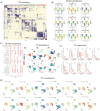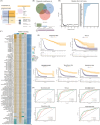Single-cell transcriptomics reveals IRF7 regulation of the tumor microenvironment in isocitrate dehydrogenase wild-type glioma
- PMID: 39492838
- PMCID: PMC11531655
- DOI: 10.1002/mco2.754
Single-cell transcriptomics reveals IRF7 regulation of the tumor microenvironment in isocitrate dehydrogenase wild-type glioma
Abstract
Mutations in isocitrate dehydrogenase (IDH) are important markers of glioma prognosis. However, few studies have examined the gene expression regulatory network (GRN) in IDH-mutant and wild-type gliomas. In this study, single-cell RNA sequencing and spatial transcriptome sequencing were used to analyze the GRN of cell subsets in patients with IDH-mutant and wild-type gliomas. Through gene transcriptional regulation analysis, we identified the M4 module, whose transcription factor activity is highly expressed in IDH wild-type gliomas compared to IDH-mutants. Enrichment analysis revealed that these genes were predominantly expressed in microglia and macrophages, with significant enrichment in interferon-related signaling pathways. Interferon regulatory factor 7 (IRF7), a transcription factor within this pathway, showed the highest percentage of enrichment and was primarily localized in the core region of wild-type IDH tumors. A machine-learning prognostic model identified novel subgroups within the wild-type IDH population. Additionally, IRF7 was shown to promote the proliferation and migration of T98G and U251 cells in vitro, and its knockdown affected glioma cell proliferation in vivo. This study systematically established the regulatory mechanism of IDH transcriptional activity in gliomas at the single-cell level and drew a corresponding cell map. The study presents a transcriptional regulatory activity map for IDH wild-type gliomas, involving single-cell RNA sequencing and spatial transcriptomics to identify gene regulatory networks, machine learning models for IDH subtyping, and experimental validation, highlighting the role of IRF7 in glioma progression.
Keywords: gene transcription regulation; glioma; interferon regulatory factor 7; isocitrate dehydrogenase 1; multi‐omics.
© 2024 The Author(s). MedComm published by Sichuan International Medical Exchange & Promotion Association (SCIMEA) and John Wiley & Sons Australia, Ltd.
Conflict of interest statement
The authors declare that they have no conflicts of interest.
Figures








References
-
- Louis DN, Perry A, Reifenberger G, et al. The 2016 World Health Organization classification of tumors of the central nervous system: a summary. Acta Neuropathol. 2016;131(6):803‐820. - PubMed
LinkOut - more resources
Full Text Sources
Miscellaneous
